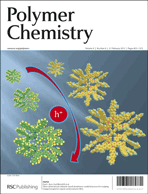Facile preparation of porous polybenzimidazole networks and adsorption behavior of CO2 gas, organic and water vapors†
Abstract
Porous polybenzimidazole networks PBI-1 and PBI-2 were synthesized through a one-step polycondensation of 3,3′-diaminobenzidine with tris(4-carboxyphenyl)amine and tetrakis(4-carboxyphenyl)silane, respectively. The polymerizations proceeded smoothly under mild conditions and were completed within a short reaction time. Using CO2 as a probe molecule, the analyses of CO2 adsorption isotherms reveal that the resultant polybenzimidazole networks belong to ultramicroporous polymers with pore sizes centered at around 5 Å. Compared to PBI-2, PBI-1 composed of triphenylamine units shows a larger Henry's constant, first virial coefficient and heat of adsorption, indicating a stronger affinity for CO2. As a result, it displays a significantly higher CO2 uptake of up to 13.2 wt% at 273 K and 1 bar. In addition, for PBI-1, the uptake capacities of benzene and water vapors are as high as 54.4 wt% and 32.9 wt%, respectively, whereas that of hexane vapor is only 1.0 wt%, exhibiting the potential applications in benzene recovery and selective removal of water from alkane solvents.


 Please wait while we load your content...
Please wait while we load your content...